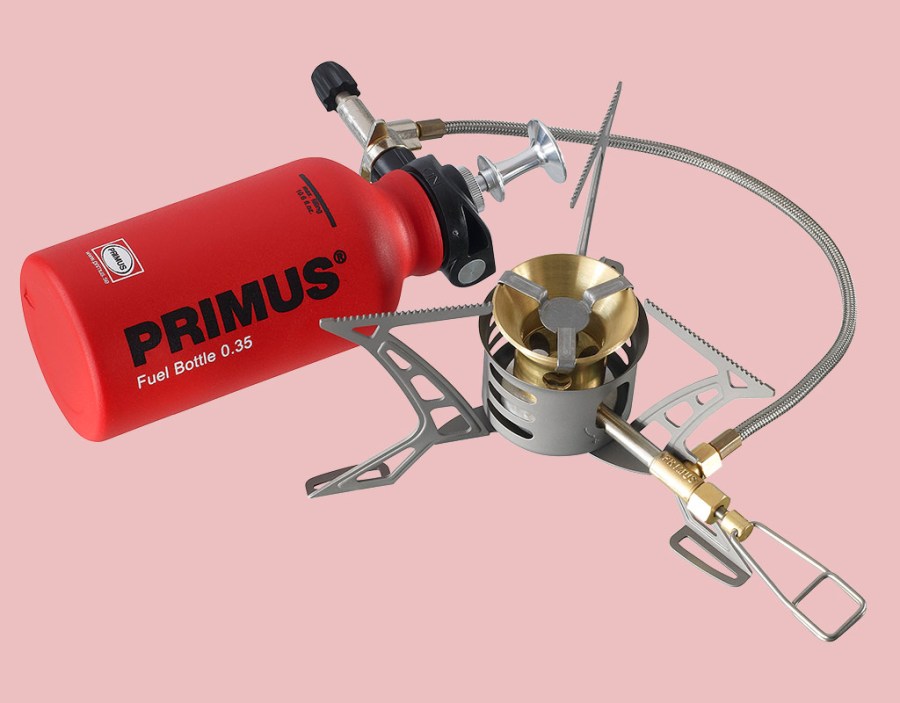As the new OmniLite Ti is a lightweight version of the Primus OmniFuel, which I gave Best Buy when I last reviewed multi-fuel stoves, I was very interested to try this stove…
The weight of the OmniFuel was its biggest drawback – it weighs 350 grams, over half as much again as the OmniLite Ti. It’s also considerably bulkier than the OmniLite when packed. The pump and windscreen weigh the same. The fuel bottle is larger – 530ml – and so heavier at 101 grams, though of course you can use any size fuel bottle.
The lower weight of the OmniLite Ti is due to the use of titanium components – the legs/pot supports and the windshield round the burner – as well as the smaller size, hence the Ti in the name. The three legs/pot supports lock into position when unfolded and are serrated to stop pots sliding off. There is a long gas control lever on the burner and a shut-off valve on the other end of the fuel line. The burner is a traditional roarer type, which means it’s noisy whatever the fuel.
Like the OmniFuel, the OmniLite is designed to use just about any petroleum fuel. However you do have to change the jet to do this. Primus says this is to ensure each fuel type burns with maximum efficiency and produces the least waste by-products. Three different diameter jets are provided. These are tiny so care has to be taken not to lose them.
Changing the jet is easily done with the supplied maintenance tool as the unit round the jet unscrews for easy access, another improvement on the OmniFuel. Liquid fuels need priming and the fuel bottle needs pressurising so it takes a bit more time and care to use them than gas cartridges.
When priming, the stove can flare so it’s important to ensure nothing flammable is above the stove, including your face! A good feature, shared with the OmniFuel, is the self-bleeding system, which means there is no spray of pressurised fuel when you detach the stove fuel line from the pump or remove the pump from the fuel bottle. To bleed the system you simply flip over the fuel bottle and wait for the flame to go out.
Most of the time I would use the OmniLite with cartridges as this is easiest and there is no need to carry the pump. As a cartridge stove the OmniLite is comparable in weight with similar remote cartridge models. I would only use it with liquid fuels on trips when extremely low temperatures were expected (consistently below -10и_C) or long trips where I couldn’t resupply with cartridges.
Primus says the OmniLite has a burner optimised for use with Eta heat exchanger pots so I tested it with the 1 litre anodized aluminium Eta pot. I also tested it with an Evernew 0.9 litre titanium pot to see how it performed with a non-heat exchanger pot. The results were surprising. I tried the stove with two different makes of 250-size isobutane/butane/propane mix canisters – Primus and Go System – and with Coleman Fuel. In each case there was no difference in the amount of fuel used to boil 500ml of water in either of the pots. The difference lay in the fuel not the pot.
Of the canisters, the Primus was the most efficient, using 8 grams of fuel. The Go System canister used 11 grams. With Coleman Fuel, 12 grams of fuel was used. In terms of boiling time the Coleman Fuel was the fastest, boiling the 500ml in a few seconds under 4 minutes with both pots. There was a difference between the two pots in boiling times with the canisters. With the Primus canister, the times were 5 minutes with the heat-exchanger pot and 6.5 minutes with the non-heat exchanger one. With the Go System canister, the times were 4 minutes with the heat-exchanger pot and 9 minutes with the non-heat exchanger pot. The air temperature was 13и_C for the canister tests and 8и_ for the Coleman Fuel test. The windscreen and pot lids were used and the water was brought to a rolling boil.
My conclusion from these tests is that with small pots there is no advantage in using a heat exchanger one, especially as these are usually heavier than non-heat exchanger models – the pots in the test weighed 293 grams for the Eta brand and 141 grams for the Evernew one. Results may be different with larger pots of course.
For the test the stove was on full power – for fuel efficiency it’s best to only have it on three-quarter power, so fuel usage in the field would probably be better than these tests suggest. Fuel could be saved when using Coleman Fuel by turning the stove off when the water has almost boiled as it takes about a minute and a half for the flame to die down. As it is, fuel usage and boil times are comparable with other stoves, both canister and multi-fuel.
With both canisters and liquid fuel, simmering is possible with care. I found that using both the valves was the best way to adjust the flame. When just using the gas control valve it was difficult to turn the flame down low enough without it going out.
Overall the OmniLite Ti is an excellent low profile multi-fuel stove. It’s light enough for solo use and powerful and stable enough for group use. The price is high but this is a top quality stove that should last well. If you want a stove that can run on a variety of fuels, this is one of the best around.








